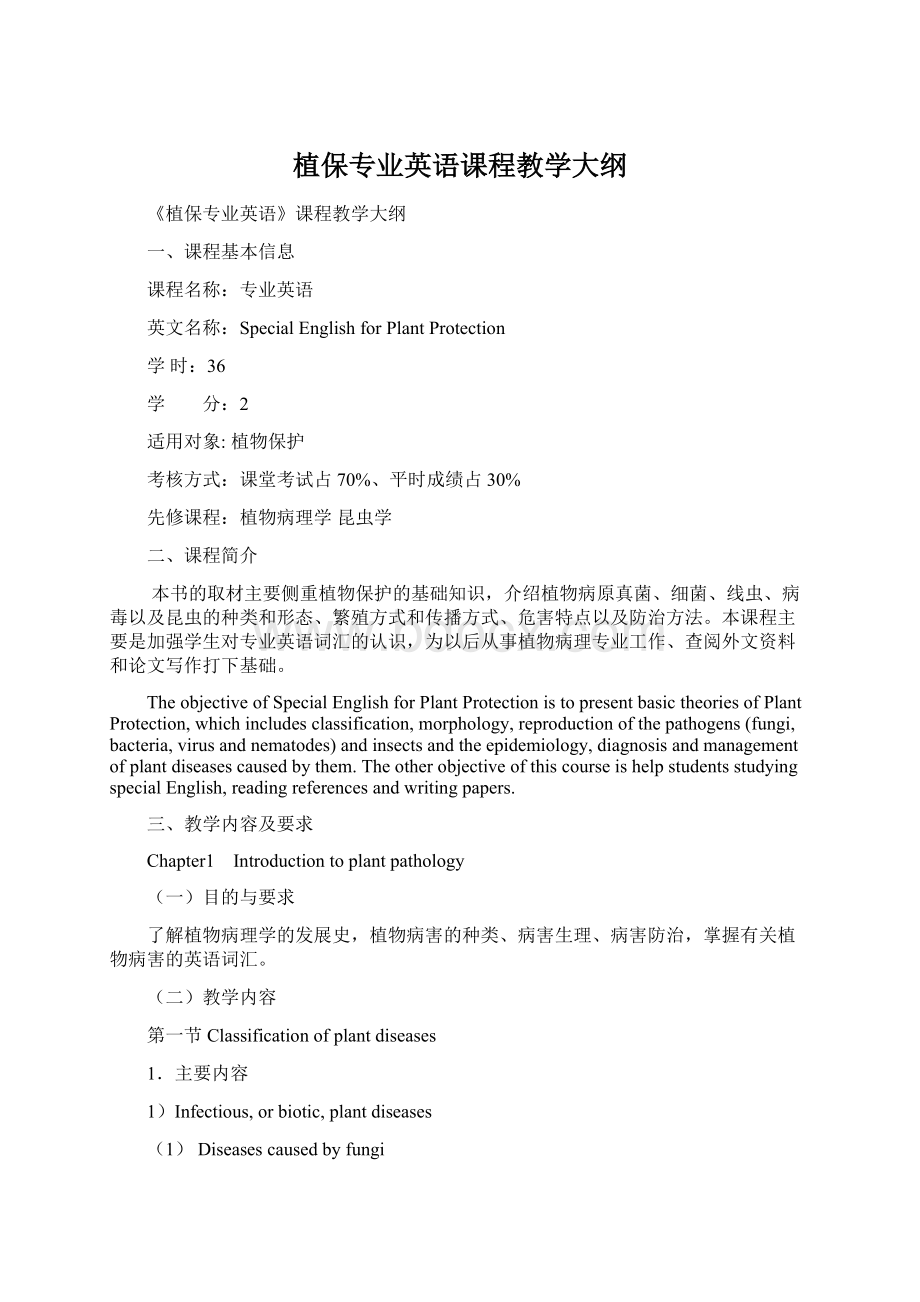植保专业英语课程教学大纲.docx
《植保专业英语课程教学大纲.docx》由会员分享,可在线阅读,更多相关《植保专业英语课程教学大纲.docx(15页珍藏版)》请在冰豆网上搜索。

植保专业英语课程教学大纲
《植保专业英语》课程教学大纲
一、课程基本信息
课程名称:
专业英语
英文名称:
SpecialEnglishforPlantProtection
学时:
36
学 分:
2
适用对象:
植物保护
考核方式:
课堂考试占70%、平时成绩占30%
先修课程:
植物病理学昆虫学
二、课程简介
本书的取材主要侧重植物保护的基础知识,介绍植物病原真菌、细菌、线虫、病毒以及昆虫的种类和形态、繁殖方式和传播方式、危害特点以及防治方法。
本课程主要是加强学生对专业英语词汇的认识,为以后从事植物病理专业工作、查阅外文资料和论文写作打下基础。
TheobjectiveofSpecialEnglishforPlantProtectionistopresentbasictheoriesofPlantProtection,whichincludesclassification,morphology,reproductionofthepathogens(fungi,bacteria,virusandnematodes)andinsectsandtheepidemiology,diagnosisandmanagementofplantdiseasescausedbythem.TheotherobjectiveofthiscourseishelpstudentsstudyingspecialEnglish,readingreferencesandwritingpapers.
三、教学内容及要求
Chapter1 Introductiontoplantpathology
(一)目的与要求
了解植物病理学的发展史,植物病害的种类、病害生理、病害防治,掌握有关植物病害的英语词汇。
(二)教学内容
第一节Classificationofplantdiseases
1.主要内容
1)Infectious,orbiotic,plantdiseases
(1)Diseasescausedbyfungi
(2)Diseasescausedbyprokaryotes(bacteriaandmycoplasmas)
(3)Diseasescausedbyparasitichigherplants
(4)Diseasescausedbyvirusesandviroids
(5)Diseasescausedbynematodes
(6)Diseasescausedbyprotozoa
2)Noninfectious,orabiotic,diseasesarediseasescausedby:
(1)Toolowortoohighatemerature(6)Nutrientdeficiencies
(2)Lackorexcessofsoilmoisture(7)Mineraltoxicities
(3)Lackorexcessoflight(8)Soilacidityoralkalinity
(4)Lackofoxygen(9)Toxicityofpesticides
(5)Airpollution(10)Improperculturalpractices
2.基本概念和知识点
1)Infectious,orbiotic,plantdiseases
2)Noninfectious,orabiotic,diseases
3.问题与应用
(1)Whataretheinfectiousdisease?
(2)Whataretheinfectiousdisease?
第二节ChapterthreeDiscoveryoftheroleoffungi
1.主要内容
1)bunt,orstinkingsmut,ofwheatisacontagiousplantdisease.Tillet,however,believedthatitwasapoisonoussubstancecontainedinthedust,ratherthanlivingmicroorganisms,thatcausedthedisease.
2)Prevostpointedouttheimportanceoftheenvironmentininductionanddevelopmentofthedisease.
3)In1861deBaryfinallyprovedexperimentallythatthefungusPhytophthorainfestanswasthecauseofthedisease.
4)DeBaryalsomadegreatcontributionswithhisstudiesofthePeronosporalesandthediseasestheyincite(downymildews).
2.基本概念和知识点
Smut、Phytophthorainfestans、Peronosporalesandthediseasestheyincite(downymildews).
1.问题与应用
1)whetheriswheatstuntcontagiousoruninfectiousdisease?
2)DoesPhytophthorainfestanscausedpotatolateblight?
第三节Controlofplantdiseases
1.主要内容
1)ThediscoveryofBordeauxmixture
2)onehostissepratedfromotherhost,inordertostopcoffeerustoutbreaks.
3)In1972,NewandKerrintroducedthefirstcommercialbiologicalcontrolofabacterialplantdisease(crowngall)byuseofanotherbacterium.
2.基本概念和知识点
Bordeauxmixture、hostsepration、biocontrol
3.问题与应用
(1)HowistheBordeauxmixtureused?
(2)Howisbiocontrolagentused?
第三节Physiologyofplantdisease
1.主要内容
1)fungiarethecausesratherthantheresultsofplantdisease,effortsbegantoelucidatethemechanismsbywhichfungicausedisease
2)pathogenproducesenzymesandtoxinsthatdegradeandkillplantcellsfromwhichthefunguscanthenobtainitsnutrients
3)toxinthatisresponsibleforthebacteria-freechloroticzone(halo)surroundingthenecroticleafspotsthatcontainthebacteria.
4)Corynebactreiumfascians,whichausesthefasciationdiseaseofpeas,producesacytokininandthatthefasciationdiseasesymptomscouldbeinducedonhealthyplantsaftertreatmentwithkinetin,whichisananimal-derivedcytokinin.
2.基本概念和知识点
(1)fungiarethecauses
(2)toxinthatisresponsibleforthebacteria-freechloroticzone(halo)
(3)pathogenproducesenzymesandtoxinsthatdegradeandkillplantcells
3.问题与应用
Howdothepathogenscauseplantdiseases?
(三)课后练习
TranslatethetextintoChinese
(四)教学手段和方法
(1)StudentsreadthetextandtranslateitintoChinese
(2)Studentsreadthetextfollowingteacher
(3)TeacheraskstudentssomequestionsinEnglish
Chapter2Pathogens
(一)目的和要求
通过学习,使学生掌握植物病原菌的一些常见英语词汇,同时加深学生的植物病理知识。
(二)教学内容
第一节Plantdiseasescausedbyfungi
1.主要内容
(1)fungalmorphology
(2)fungaldefinition
(3)reproduction(sexualandasexualreproduction)
(4)homothallic,heterothallic,hermaphroditicfungi
(5)Deuteromycetes,ascomycetes,basidiomycetes,zygomycetes,mastigomycetes
2.基本概念和知识点
(1)fungaldefinition
(2)reproduction(sexualandasexualreproduction)
(3)homothallic,heterothallic,hermaphroditicfungi
(4)Deuteromycetes,ascomycetes,basidiomycetes,zygomycetes,mastigomycetes
3.问题与应用
(1)fungaldefinition
(2)reproduction(sexualandasexualreproduction)
(3)homothallic,heterothallic,hermaphroditicfungi
第二节Plantdiseasescausedbyprokaryotes
1.主要内容
1)Introductiontoprokaryotes
2)Classificationofprokaryotes
3)Kingdom:
Prokaryote:
Organismswithgeneticmaterial(DNA)notorganizedintoanucleus,i.e.,notsurroundedbyamembrane.Bacteria:
Havecellmembraneandcellwall.PartⅠ:
Gram-negativeaerobicrodsandcocci.PartⅡ:
Gram-negativefacultativeanaerobicrods.PartⅢ:
Irregular,Gram-positive,nonsporingrods.PartⅣ:
Actinomycetes:
Bacteriaformingbranchingfilaments.PartⅤ:
Mollicutes:
Prokaryotesthathaveacellmembranebutnocellwall.
4)Plantdiseasescausedbybacteria
5)Morphology
6)Plantdiseasescausedbymycoplamalikeorganisms
2.基本概念和知识点
1)mycoplasmalikeorganisms(MLO),rickettsialikeorganisms,spiroplasma
2)morphologyofprokaryotes
3)diseasescausedbyprokaryotes
4)classificationofprokaryotes
3.问题与应用
(1)Howmanygeneraisprokaryotesclassified?
(2)Canprokaryotesbecultured?
第三节Plantdiseasescausedbyviruses
1.主要内容
1)Introductiontoviruses
2)constituentsofvirus
3)disruptingactionofvirustohostcell
4)Characteristicsofplantviruses
5)Detection
6)Satelliteviruses,viroids,virusoids,andsatelliteRNAs
7)Specificcropdiseasesbyviruses
2.基本概念和知识点
1)morphologyofvirus
2)multiplication
3)classification
4)detection
3.问题与应用
1)whatshapedoesvirusshow?
2)Howdoesvirusmultiply?
3)Howarevirusesclassified?
第三节Plantdiseasescausedbynematodes
1.主要内容
1)Introduction
2)Morphology
3)Anatomy
4)Lifecycles
5)Ecologyandspread
2.基本概念和知识点
1)esophagus,intestine,rectum,,anus,stylet,oviduct,uterus,vulva.,testis,seminalvesicle,intestine.copulatoryspicules,hermaphroditic,orparthenogenetic.
2)Allnematodeshavefourlarvalstages,
3)familyAphelenchoididae,Bursaphelenchus,Rhadinaphelenchus,root-knotnematodes:
Meloidogyne
3.问题与应用
1)whatstagedoesthenematodebegintopenetrateplant?
2)whatcharacteristicsdoBursaphelenchus,RhadinaphelenchusandMeloidogynehave?
(三)课后练习
TranslatethetextintoChinese
(四)教学手段和方法
(1)StudentsreadthetextandtranslateitintoChinese
(2)Studentsreadthetextfollowingteacher
(3)TeacheraskstudentssomequestionsinEnglish
Chapter3Plantdiseasediagnosis---Finaldiagnosis
(一)目的与要求
通过学习植物病害发生特点、病状类型、病征类型、田间分布状况,初步掌握病害的诊断方法,为病害防治打下基础。
(二)教学内容
1.主要内容
1)Plantdiseasediagnosis
(1)beabletoidentifyadiseaseanddisease-causingagent,
(2)beabletonarrowtheproblemdowntoseveralpossibilitiesthatwillrequirefurtherstudyinthelaboratorybeforehecanmakeafinaldiagnosis,or
(3)becompletelybaffledbytheproblem.
2)Finaldiagnosis
(1)hypothesisandmultipleiteration
(2)Fungalleafspots
(3)Bacterialleafspots
(4)Veinbanding
(5)MosaicandRingspot
(6)Leafdistortion
(7)Powderymildew
(8)Presenceofspores/sporestructures
(9)Leaforneedletipdeath
(10)Soilorchemicalinjury
(11)Wilts
(12)Shootdieback(顶枯)orblights
(13)Dyingbranchesoftreesandshrubs
(14)Deathoftreeandshrubtop
(15)Overallstuntingordecline
(16)Damping-off
2.基本概念和知识点
Hypothesis,iteration,symptom(generalandspecial),sign(pathogenicstructure),
3.问题与应用
(1)Howdoyoudiagnoseplantdiseases?
(2)Illustratethedifferencebetweeninfectiousanduninfectiousdiseases
(三)课外练习
TranslatethetextintoChinese
(四)教学手段和方法
(1)StudentsreadthetextandtranslateitintoChinese
(2)Studentsreadthetextfollowingteacher
(3)TeacheraskstudentssomequestionsinEnglish
Chapter4Cultivarmixtures
(一)目的与要求
通过学习作物的混合栽培,了解其对病原物传播和病原物多样性的影响、对病原物稳定化选择的作用,揭示生物多样性对病害防治的作用机理。
(二)教学内容
1.主要内容
1)Introductiontocultivarmixture
2)Anegativeconsequenceofgeneticuniformity
3)Asimplewaytoenhancegeneticdiversityistomixtheseedofcultivars(i.e.plantgenotypes)thatvaryintheirsusceptibilitytospecificpathogens.Thismethodensuresgeneticdiversificationwiththeadvantagethatitcanbeusedinadditiontoanyotherformofdiseasecontrol.
4)Whatisacultivarmixture?
5)Mechanismsbywhichcultivarmixturessuppressdisease
(1)Dilutioneffect
(2)Barriereffect.
(3)Inducedresistance.Inducedresistanceoccurswhenbiochemicalhostdefensesaretriggeredbyinoculationwithanavirulentrace.Triggeringthesedefensesslowstheinfectionprocessofvirulentpathogenracestowhichthehostisnormallysusceptible(more---).
(4)Cropsanddiseasessuitedtocultivarmixtures
a.Sizeofgenotypeunitarea
b.Steepnessofdispersalgradient
c.Ultimatelesionsize
d.Pathogengenerationtime
6)China:
Efficacyofricemitureagainstriceblast
7)USA:
Effectofcultivarmixtures
2.基本概念和知识点
(1)cropmixture
(2)geneticuniformity
3)physiologicrace
4)geneticvulnerability
5)geneticstabilization(stabilizationchoice)
3.问题与应用
1)Howisgeneticstabilizationmade?
2)Howisgeneticvulnerabilitycaused?
3)Howareplantdiseasescontrolledbasedoncropmixture?
(三)课外练习
1)TranslatethetextintoChinese
2)Studentssearchforinformationaboutplantdiseasecontrolbasedoncropmixtureontheinternet
(四)教学手段和方法
(1)StudentsreadthetextandtranslateitintoChinese
(2)S